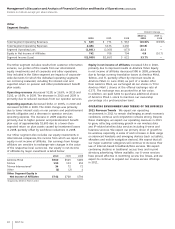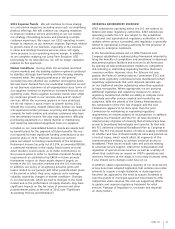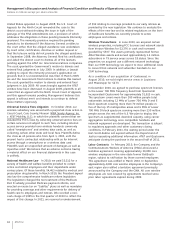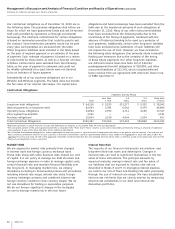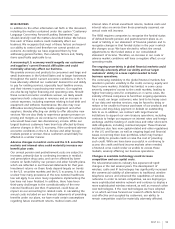AT&T Wireless 2010 Annual Report Download - page 48
Download and view the complete annual report
Please find page 48 of the 2010 AT&T Wireless annual report below. You can navigate through the pages in the report by either clicking on the pages listed below, or by using the keyword search tool below to find specific information within the annual report.
Management’s Discussion and Analysis of Financial Condition and Results of Operations (continued)
Dollars in millions except per share amounts
46 AT&T Inc.
Wireless FCC licenses are tested for impairment on an
aggregate basis, consistent with the management of
the business on a national scope. As in prior years, we
performed our test of the fair values of FCC licenses using
a discounted cash flow model (the Greenfield Approach).
The Greenfield Approach assumes a company initially
owns only the wireless FCC licenses, and then makes
investments required to build an operation comparable to
the one that currently utilizes the licenses. We utilized a
17-year discrete period to isolate cash flows attributable
to the licenses, including modeling the hypothetical
build-out. The projected cash flows are based on certain
financial factors, including revenue growth rates, OIBDA
margins, and churn rates. We expect wireless revenue
growth to trend down from our 2010 growth rate of 9.3%
to a long-term growth rate that reflects expected long-
term inflation trends. We expect our churn rates to
continue to decline from 1.31% in 2010, in line with
expected trends in the industry but at a rate comparable
with industry-leading churn. OIBDA margins should
continue to trend above 40.0%.
This model then incorporates cash flow assumptions
regarding investment in the network, development of
distribution channels and the subscriber base, and other
inputs for making the business operational. We based the
assumptions, which underlie the development of the
network, subscriber base and other critical inputs of the
discounted cash flow model on a combination of average
marketplace participant data and our historical results,
trends and business plans. We also used operating metrics
such as capital investment per subscriber, acquisition costs
per subscriber, minutes of use per subscriber, etc., to
develop the projected cash flows. Since we included the
cash flows associated with these other inputs in the
annual cash flow projections, the present value of the
unlevered free cash flows of the segment, after investment
in the network, subscribers, etc., is attributable to the
wireless FCC licenses. The terminal value of the segment,
which incorporates an assumed sustainable growth rate, is
also discounted and is likewise attributed to the licenses.
We used a discount rate of 9.0%, based on the optimal
long-term capital structure of a market participant and
its associated cost of debt and equity, to calculate the
present value of the projected cash flows. This discount
rate is also consistent with rates we use to calculate the
present value of the projected cash flows of licenses
acquired from third parties.
If either the projected rate of long-term growth of cash
flows or revenues declined by 1%, or if the discount rate
increased by 1%, the fair values of the wireless FCC
licenses, while less than currently projected, would still be
higher than the book value of the licenses. The fair value of
the licenses exceeded the book value by more than 25%.
Alternatively, we could have chosen to amortize customer
relationships using the straight-line method, which would
allocate the cost equally over the amortization period.
Amortization of other intangibles, including patents and
certain trade names, is determined using the straight-line
method of amortization over the expected remaining
useful lives.
Goodwill and wireless FCC licenses are not amortized but
tested annually for impairment. We conduct our impairment
tests as of October 1. We test goodwill on a reporting unit
basis, and our reporting units coincide with our segments,
except for certain operations in our Other segment.
The goodwill impairment test is a two-step process.
The first step involves determining the fair value of the
reporting unit and comparing that measurement to the
book value. If the fair value exceeds the book value, then
no further testing is required. If the fair value is less than
the book value (i.e., an impairment exists), then we
perform a second step.
In the second step, we determine the fair values of all of
the assets and liabilities of the reporting unit, including
those that may not be currently recorded. The difference
between the sum of all of those fair values and the overall
reporting unit’s fair value is a new implied goodwill
amount, which we compare to the recorded goodwill.
If implied goodwill is less than the recorded goodwill,
then we record an impairment of the recorded goodwill.
The amount of this impairment may be more or less than
the difference between the overall fair value and book
value of the reporting unit. It may even be zero if the fair
values of other assets are less than their book values.
Goodwill is the only asset that may be impaired when
performing the goodwill impairment test.
As shown in Note 6, more than 99% of our goodwill
resides in the Wireless, Wireline, and Advertising Solutions
segments. For each of those segments, we assess their
fair value using a market multiple approach and a
discounted cash flow approach. Our primary valuation
technique is to determine enterprise value as a multiple
of a company’s Operating Income Before Depreciation
and Amortization (OIBDA). We determined the multiples
of the publicly traded companies whose services are
comparable to those offered by the segment and then
calculate a weighted average of those multiples.
Using those weighted averages, we then calculated fair
values for each of those segments. We also perform
a discounted cash flow analysis as a secondary test of
fair value to corroborate our primary market multiple
test. The calculated fair value exceeded book value
in all circumstances and no additional testing was
necessary. In the event of a 10% drop in the fair values
of the reporting units, the fair values would have still
exceeded the book values of the reporting units and
additional testing would still have not been necessary.






